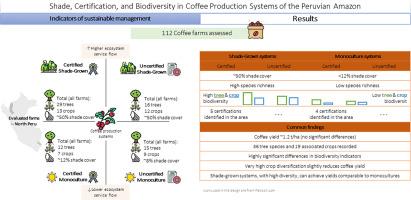平衡秘鲁亚马逊咖啡种植园的树木和作物生物多样性和产量:遮荫和认证作为可持续管理指标的作用
Q2 Environmental Science
引用次数: 0
摘要
在全日照单一栽培中集约化种植咖啡往往与生物多样性丧失有关。在这方面,农林业系统因其协调农业生产力与环境保护的能力而日益受到重视,特别是在热带地区。本研究评估了秘鲁北部亚马逊地区四种咖啡生产系统的产量、树木和作物多样性以及遮荫覆盖率:经认证的遮荫、未经认证的遮荫、经认证的单一栽培和未经认证的单一栽培。虽然平均产量没有显著差异,但遮荫系统表现出更大的生物多样性,其中经认证的遮荫系统显示出最高的生物多样性。然而,作物过度多样化与产量负相关,特别是在经认证的农场。遮荫盖度与树种丰富度呈正相关,表明30 - 50%是平衡生产力和生态系统服务的最佳范围。认证并不总是与更高的生物多样性联系在一起,这引发了对其有效性和实施的质疑。研究结果强调了荫蔽农林业系统在实现生态和经济目标方面的可行性。我们建议推广具有可量化生物多样性指标的认证计划,提供技术援助,并建立激励机制,以保持足够的树荫覆盖和物种多样性。这些战略可以增强农场的抵御能力,保护重要的栖息地,并支持亚马逊咖啡种植区的可持续发展。本文章由计算机程序翻译,如有差异,请以英文原文为准。

Balancing tree and crop biodiversity and yield in coffee plantations of the Peruvian Amazon: The role of shade and certification as indicators of sustainable management
Intensive coffee cultivation in full-sun monocultures is often associated with biodiversity loss. In this context, agroforestry systems are increasingly valued for their ability to reconcile agricultural productivity with environmental conservation, especially in tropical regions. This study evaluated yield, tree and crop diversity, and shade cover across four coffee production systems in northern Peruvian Amazonia: certified shaded, uncertified shaded, certified monoculture, and uncertified monoculture. While no significant differences in average yields were found, shaded systems exhibited greater biodiversity, with the certified shaded system showing the highest values. However, excessive crop diversification was negatively associated with yield, particularly in certified farms. Shade cover was positively correlated with tree species richness, suggesting an optimal range of 30–50 % to balance productivity and ecosystem services. Certification was not consistently linked to higher biodiversity, raising questions about its effectiveness and implementation. Findings highlight the viability of shaded agroforestry systems in achieving ecological and economic goals. We recommend promoting certification schemes with quantifiable biodiversity indicators, providing technical assistance, and establishing incentives to maintain adequate shade cover and species diversity. These strategies can enhance farm resilience, conserve critical habitats, and support sustainable development in coffee-growing landscapes of the Amazon.
求助全文
通过发布文献求助,成功后即可免费获取论文全文。
去求助
来源期刊

Environmental Challenges
Environmental Science-Environmental Engineering
CiteScore
8.00
自引率
0.00%
发文量
249
审稿时长
8 weeks
 求助内容:
求助内容: 应助结果提醒方式:
应助结果提醒方式:


